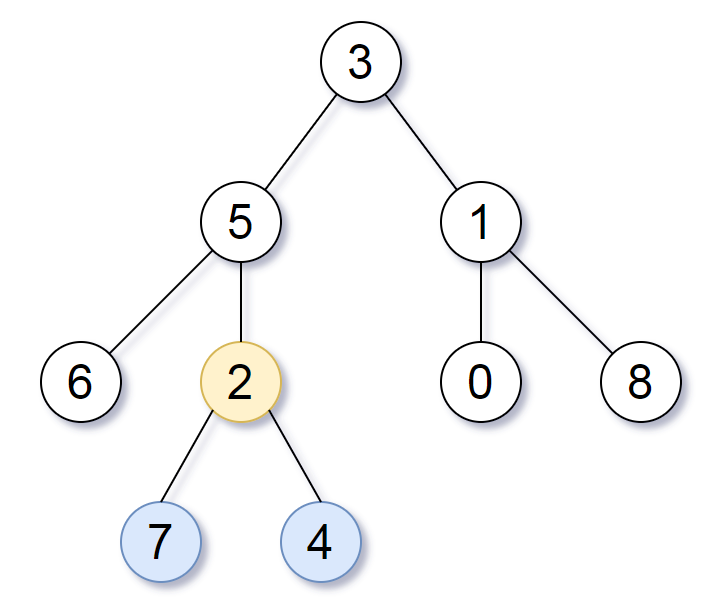Appearance
每天一道Rust-LeetCode(2019-10-29)
坚持每天一道题,刷题学习Rust.
题目描述
给定一个根为 root 的二叉树,每个结点的深度是它到根的最短距离。
如果一个结点在整个树的任意结点之间具有最大的深度,则该结点是最深的。
一个结点的子树是该结点加上它的所有后代的集合。
返回能满足“以该结点为根的子树中包含所有最深的结点”这一条件的具有最大深度的结点。
示例:
输入:[3,5,1,6,2,0,8,null,null,7,4] 输出:[2,7,4] 解释:  我们返回值为 2 的结点,在图中用黄色标记。 在图中用蓝色标记的是树的最深的结点。 输入 "[3, 5, 1, 6, 2, 0, 8, null, null, 7, 4]" 是对给定的树的序列化表述。 输出 "[2, 7, 4]" 是对根结点的值为 2 的子树的序列化表述。 输入和输出都具有 TreeNode 类型。
我们返回值为 2 的结点,在图中用黄色标记。 在图中用蓝色标记的是树的最深的结点。 输入 "[3, 5, 1, 6, 2, 0, 8, null, null, 7, 4]" 是对给定的树的序列化表述。 输出 "[2, 7, 4]" 是对根结点的值为 2 的子树的序列化表述。 输入和输出都具有 TreeNode 类型。
提示:
树中结点的数量介于 1 和 500 之间。 每个结点的值都是独一无二的。
来源:力扣(LeetCode) 链接:https://leetcode-cn.com/problems/smallest-subtree-with-all-the-deepest-nodes 著作权归领扣网络所有。商业转载请联系官方授权,非商业转载请注明出处。
解题思路
如果root左右子树深度都一样,那么root就是要找到那个节点 否则就去他深度最深的那颗子树上去找
解题过程
rust
use crate::share::TreeNode;
use std::cell::RefCell;
use std::cmp::max;
use std::rc::Rc;
struct Solution {}
impl Solution {
pub fn subtree_with_all_deepest(
root: Option<Rc<RefCell<TreeNode>>>,
) -> Option<Rc<RefCell<TreeNode>>> {
let r = root.expect("must have one node"); //至少有一个节点
let ldepth = Solution::depth(r.borrow().left.clone());
let rdepth = Solution::depth(r.borrow().right.clone());
if ldepth == rdepth {
//左右深度相同,他就是要找的了
return Some(r);
}
if ldepth > rdepth {
return Solution::subtree_with_all_deepest(r.borrow().left.clone());
} else {
return Solution::subtree_with_all_deepest(r.borrow().right.clone());
}
}
fn depth(root: Option<Rc<RefCell<TreeNode>>>) -> u32 {
if root.is_none() {
return 0;
}
let r = root.unwrap();
return max(
Solution::depth(r.borrow().left.clone()),
Solution::depth(r.borrow().right.clone()),
) + 1;
}
}
#[cfg(test)]
mod test {
use super::*;
use crate::share::*;
#[test]
fn test_find_duplcates_tree() {
let t = build_tree_ignore_parent(&vec![3, 5, 1, 6, 2, 0, 8, null, null, 7, 4]);
let r = Solution::subtree_with_all_deepest(t.clone());
assert_eq!(2, r.unwrap().borrow().val);
}
}
一点感悟
此方法需要多次求深度,存在优化空间
其他
欢迎关注我的github,本项目文章所有代码都可以找到.
 Steven's Blog
Steven's Blog